Exploring the Exotic Fresh Fruit of Mexico
Article and photos by Ted Campbell
12/23/2015
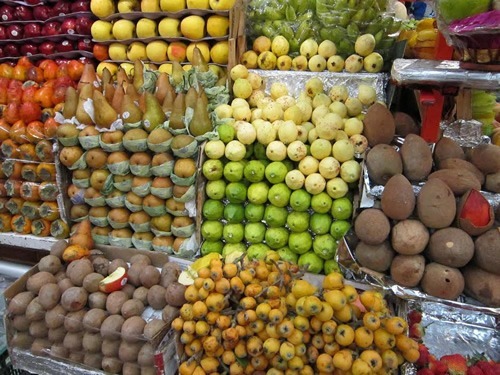 |
| A sample of assorted fruits in Mexico. |
If you visit Mexico and don’t eat fresh fruit, you are really missing out.
High quality fruit piles high in markets, street corners, and fruit shops in every nook and cranny of Mexico. From the exotic pitahaya to the everyday orange, fruit here is plentiful, diverse, and cheap.
If you come from a northern country, just try a banana. Tell me it isn’t the best banana you’ve ever had.
Bananas travel north to the U.S. and elsewhere from Mexico and Central America. They are picked early in order to survive the journey, so they ripen on the way. Therefore they’re not nearly as good as when they are given time to ripen on the tree.
Or take the humble orange. The ones grown in Florida were bred to have that thick white skin you have to tear through and then pick off. It makes oranges easier to ship and less prone to bruising. But the result is that sometimes the orange is so dry you almost have to choke it down.
Not here in Mexico. Oranges have thin skin and are heavy with juice. When in season — most of the year except late summer — they cost around 10 pesos (US$0.80) for 3 to 5 kilos.
Don’t buy fruit at the supermarket. Sure, some things like pineapples and bananas will be good. But because most of the fruit on this list is seasonal or regional, for it to make the trip down the supply chain to a big-box supermarket like Wal-Mart, it must be picked green as well.
Instead, seek out the mercado municipal (municipal market) anywhere in Mexico. You’ll see different fruit in different states, and each time you’ll see something you’ve never tried or even heard of before. If someone offers you a sample, take it!
Also, you can get good fruit in fruit shops and on the street. Fruit trucks sell whatever is in season at low prices. Sometimes people will even walk around selling delicious seasonal fruit out of wheelbarrows.
Yes, most guidebooks warn about getting sick from eating fruit, but these warnings are unfounded. Give the fruit a good washing and you’ll be fine, and if it has the natural protection of a peel, you have nothing to worry about.
Even fruit that’s already cut should be safe. The main danger in eating cut fruit is when someone uses the knife to cut meat, and then uses it on the fruit without washing it first. So if you order a fruit cocktail from a juice bar with no meat on the menu, you should have no problem.
Finally, if you are in the mood for dessert or a cool drink, then look for these fruits in juices (jugos), smoothies (licuados), or ice-cream (helados or nieves), which are widely available all over Mexico in juice bars, ice-cream shops, or on the street.
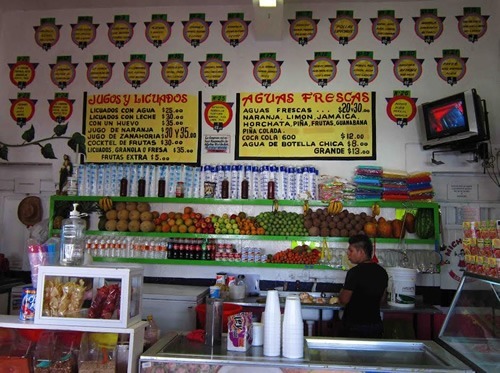 |
| A typical juice bar in Mexico. |
I refer to each fruit by its most commonly used name in Mexican Spanish, followed by the name in English (if I know what it is).
Pitahaya (Dragon Fruit)
Pitahaya is a fist-sized flaming pink and green fruit that grows on a cactus native to the Sonoran desert in Mexico. It was later introduced to Southeast Asia, where it acquired its name in English, dragon fruit.
A ripe pitahaya has a strong flavor and a kiwi-like texture. In Mexico I’ve always seen some that are white inside, but in Guatemala they can be purple and much stronger.
Unfortunately pitahaya is sometimes a little bland, in sharp contrast to its wild exterior. If you get a bland one, don’t despair. When you get a strong, good one, you’ll know it. Keep looking.
They are easy to eat. Just cut it in half and spoon out the fruit.
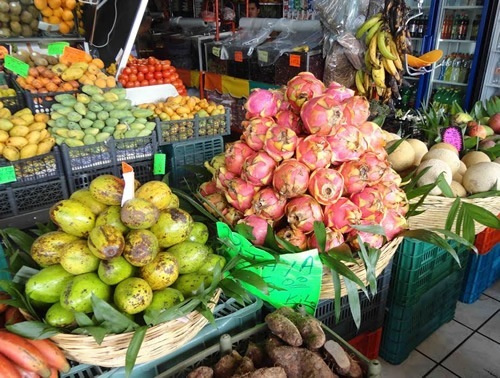 |
| Pitahaya at a market in Mexico. |
Mamey
Highly nutritious mamey is also native to Mexico and Central America, where it grows on a large ornamental tree. The fruit ranges from avocado to football size, and has a thick brown peel.
What color is the fruit under the peel — red? Red-brown? Rust? It’s hard to say, and the flavor is difficult to describe as well. It’s almost like an angry avocado: similar shape, similar textures inside and out, and a similar cutting method (slice along the pit and spoon out) — though a different color and a flavor like a cinnamon-sweet pumpkin.
Also, like the avocado, squeeze a mamey to know if it’s ripe, but there might still be hard parts inside. It is best to cut a little hole in the peel a few days before you want to eat it, so it will ripen all the way through.
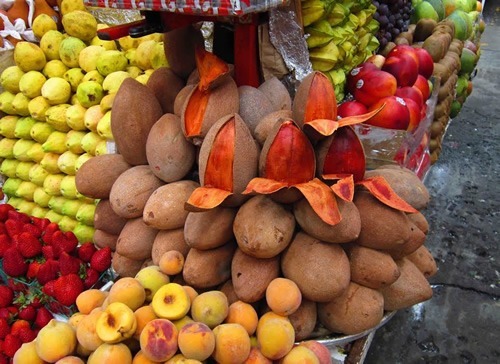 |
| Mamey at a market in Mexico. |
Mangosteen
Mangosteen is an import from tropical Asia, and therefore somewhat uncommon in Mexico. About the size of a tomato, it has a hard purple skin with four or five thick leaves growing out from the stem.
Beneath its modest purple exterior is a powerfully delicious white fruit that surrounds almond-sized seeds.
In a huge market full of all kinds of fruit, you might only find one vendor selling mangosteen. Therefore, it will certainly be more expensive than other choices, but if you are a fruit lover and run across mangosteen, buy it, whatever the price.
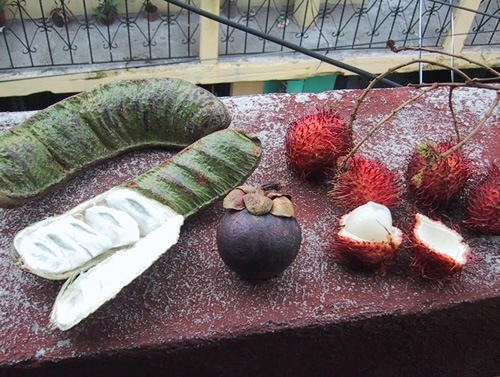 |
| Mangosteen fruit. |
Papausa
Papausa grows on a tree native to Central America and southern Mexico — you will find it in the markets of Chiapas in August. It is the size of a small melon with a greenish-purple, tough looking skin that begins to crack open when it’s ripe.
Papausa is similar to the guanabana (soursop), both in texture and flavor, but it is a different fruit and harder to find.
Under the lumpy, cracked exterior is a sweet, ice-cream-like fruit that surrounds smooth black seeds. And you’ll never know until you open it if you have a pink or white one — each has a different flavor.
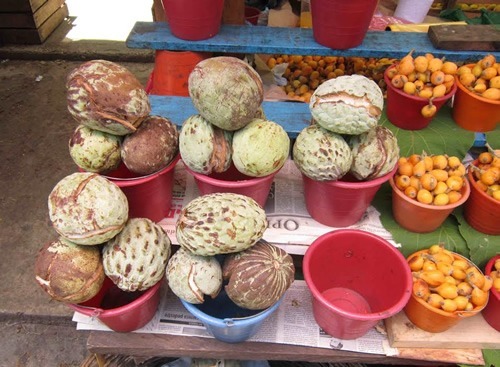 |
| Papausa at a market in Mexico. |
Rambutans
Originally from Southeast Asia, rambutan is a common sight in southern Mexico, especially the state of Chiapas. During rambutan season in the summer, you can buy them from wheelbarrows on the street.
Rambutans are the size of a golf ball and are easy to spot because they are covered with long red “hairs.” A bag of rambutans makes a great companion on any adventure in Chiapas — to Mayan ruins, indigenous towns, or the beach. They last a long time because of a thick skin, and even when the skin begins to turn black, the fruit inside is probably still good.
It’s easy to eat: pierce the skin with a thumbnail and pull the skin apart. Pop the whole fruit in your mouth and eat around the seed. Delicious.
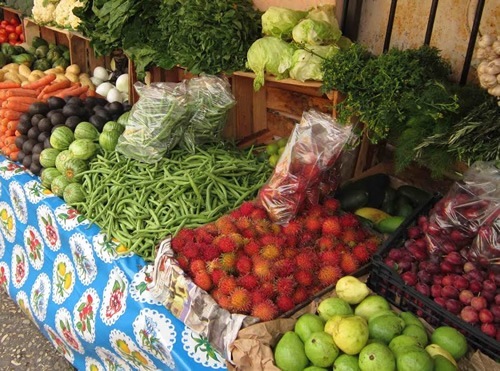 |
| Rambutans at a market in Mexico. |
Lychee
Native to China, the lychee is usually better known by international folks than its two cousins rambutan and huaya (see below). However, in Mexico lychees are harder to find. If you run into them — especially in late summer — buy, buy, buy.
The lychee is about the size of a big grape and tastes similar, but it has a hard, thin brownish red skin. Crack it open, pop the fruit in your mouth, and eat around the smooth black seed.
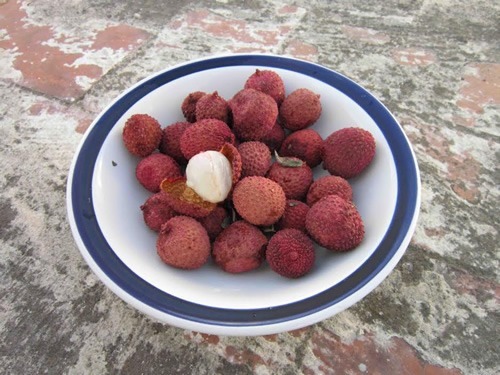 |
| Lychees. |
Huayas / Guayas
Little bunches of grape-sized huayas (pronounce why-yu) are also sold on the street and out of wheelbarrows in southern Mexico, especially the Yucatan. They have a hard green shell with an off-white flesh inside that surrounds an inedible seed that looks like a garbanzo bean.
Like the rambutan, huayas are also sometimes mistaken for the better-known lychee, which though also available in Mexico is less common. While the rambutan and lychee taste somewhat like a grape, the huaya is more sour and has a slightly tougher texture. It’s a little hard to crack open, so try piercing it with your teeth first.
While rambutans and lychees are originally come from Asia, huayas are native to southern Mexico, Central America, and the Caribbean.
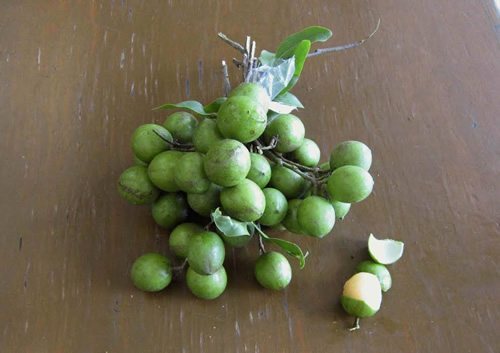 |
| Guayas fruit. |
Paterna / Cushin
Paterna, known as cushin in Mayan (in Guatemala), looks like a big pea pod. Inside is a cotton-candy fruit on big black inedible seeds. They have a soft texture and a good flavor, but eat too many of them and your mouth will go numb.
It’s easier to find in Guatemala than in Mexico, though I have spotted it in out-of-the way places in Chiapas. It’s easy to carry and fun to eat, so if you see them, pick up a bundle.
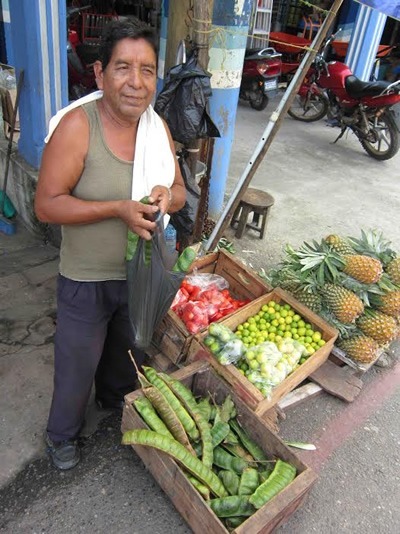 |
| Man selling paterna and other fruits at a market. |
Carambola (Star Fruit)
Look at the carambola lengthwise and it’s the perfect shape of a five-pointed star — hence the English name star fruit.
Originally from Southeast Asia and India, carambola grows in bunches on tropical trees. They are available year-round in Mexico, but aren’t so common — look for them in markets.
The carambola looks complicated, but it’s not — you eat the whole thing, though they are often quite sour. So, better yet, grind up four in a blender with a liter of water and very little sugar and strain out the big chunks. Somehow this kills the sourness.
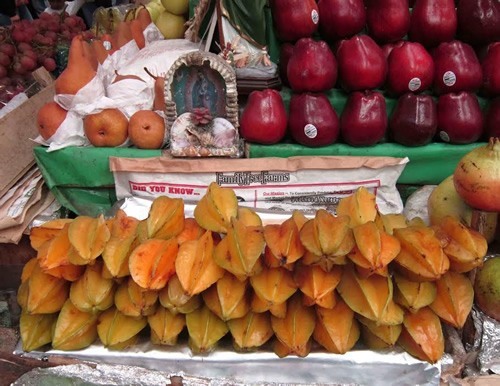 |
| Carambola (star fruit) at a market in Mexico. |
Guayaba (Guava)
Delicious and nutritious, guayabas in Mexico are usually white, sometimes pink, and are often covered in red spots. While in most places they are between the size of a golf ball and a baseball, in southern Mexico you can find them the size and shape of big pears.
Guayabas are native to Mexico and very common. Available year-round, they are included in most fruit cocktails and are often made into drinks. They have a light, very subtle, almost pungent flavor.
Wash them well and eat the whole thing. The consistency is quite soft except for hard, unchewable seeds that you are tempted to spit out, but there are far too many. So you have to gum them. But if you dig the taste, then getting over the hard seeds is easy.
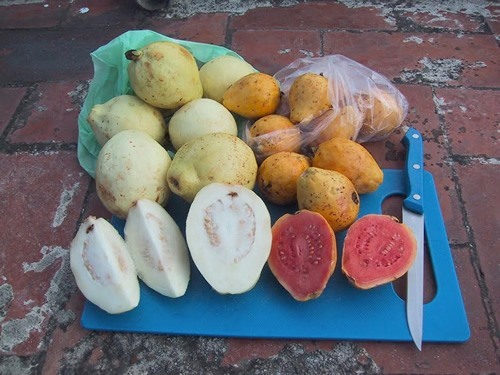 |
| Guayaba (guava) fruit at the market. |
Tuna (Prickly Pear)
By sight, you would think the tuna is a vegetable, or if you only heard the name you would assume it was the fish. (Language note: the fruit is called tuna; tuna fish is called atun.)
Tunas come in green or purple, both the skin and flesh, and they have different flavors — purple is a little stronger and sweeter, though green is good as well.
These grow atop the nopal cactus. You can eat the leaves of the cactus too — they must be cooked, either fried or grilled. Both the leaves and the fruit are common year round in Mexico, and eating them is a truly Mexican experience. Did you know that cactus was edible?
Tunas are easy to peel. Just cut into the skin and pull it back. The fruit is soft with short fibers, and like the guayaba it has hard seeds that can’t be chewed. Don’t let them put you off — you’ll get used to swallowing them.
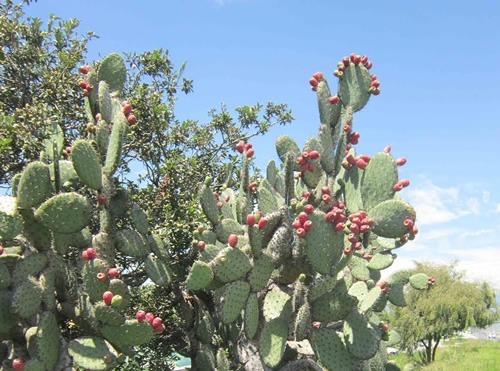 |
| Tuna (prickly pear) fruit. |
Xoconostle
When you see a pre-Hispanic name like that, you know the fruit is native Mexican.
Small and colorful, Xoconostle may look like a cross between the tuna and the guayaba, but it has a distinctly powerful, bitter flavor. That’s why it’s usually included in juice mixtures rather than eaten straight.
Buy some to munch on if you are curious, but you are better off ordering them in a juice mixture — read the juice bar menu closely.
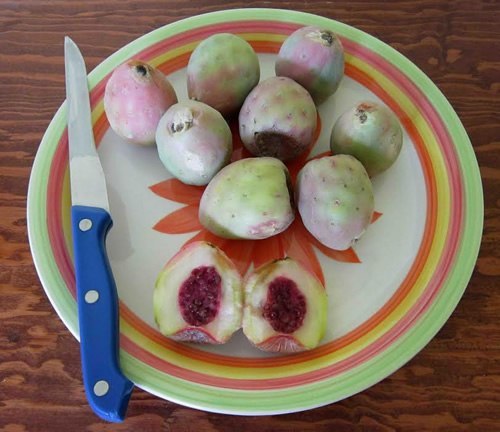 |
| Xoconostle fruit. |
Noni
Noni is a funny-looking fruit: green, lumpy, and about the size of your fist. It originally comes from Southeast Asia.
Noni apologists say that it tastes like funky blue cheese. Others, like me, simply say that it tastes nasty.
But noni purportedly has great health benefits. If you want to eat noni but can’t get past the taste, blend it up with sugar and other fruits and drink it.
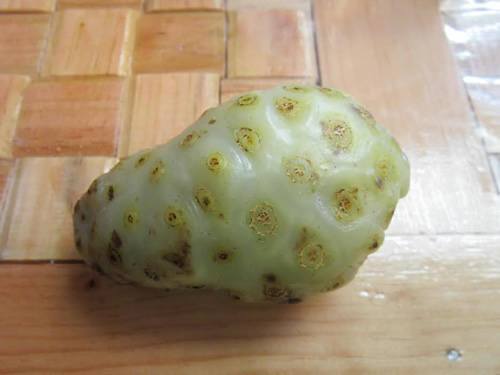 |
| Noni fruit. |
Capulines (Chokecherry)
It looks like a miniature cherry, minus the curvy stem. But it has a flatter flavor, less sweet but not sour. Eat them like a cherry — don’t bite into the pit.
Apparently capuline trees only grow in a few, high-altitude parts of Mexico and also Canada. They come into season in late summer and can be bought from indigenous Otomi ladies on the streets of Temoaya, about an hour from Toluca, the capital of the State of Mexico.
They are also commonly made into jams, although your jam may still contain the rock-hard pits.
Watch your Spanish pronunciation: capulines are chokecherries, while chapulines are fried crickets.
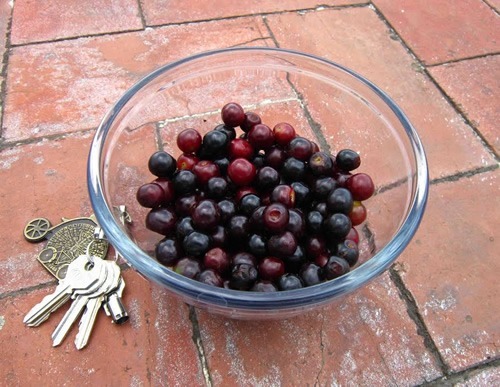 |
| Capulines (chokecherry) fruit. |
Granada China (Sweet Granadilla)
Egg-shaped outside, with crunchy black seeds and a mucus-like texture inside, granada china is weird no matter how you look at it. In fact, an alternate name for it in Mexico is granada de moco — mucus granada.
It is native to the mountains of South America but is also produced in Mexico, and along with the fruit, a psychedelic flower grows on the plant.
They are available year round, easy to eat, and quite good.
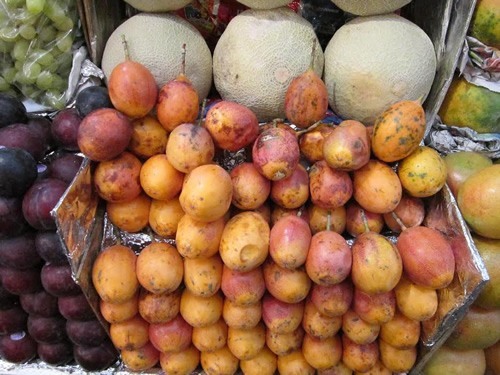 |
| Granada China (sweet granadilla) fruit. |
Bonus: Pomegranates and Mangos
Pomegranates (granada in Spanish) and mangos are two of the tastiest fruits around, and here in Mexico they are much cheaper than in the U.S. and beyond.
Pomegranates are in season in late summer and early fall in central Mexico. Buy them then and they will be much better and much cheaper than other times of the year.
They figure prominently in chiles en nogada, a famous dish from Puebla. Chiles en nogada is a big bell pepper stuffed with meat and fruit and covered in walnut sauce, parsley, and pomegranate seeds. It’s easily one of the best meals in Mexico.
The pomegranate is well known, but perhaps you don’t know how to peel it. First, cut off the top in a little circle. Then make shallow slices along the ridges of the fruit. The idea is to not cut into the red, fruit-covered seeds.
With the top off and slices along the ridges, you can pull the fruit apart and have some nice chunks to eat from. You can eat the white stuff too, so don’t bother picking it off each seed. Just bite right in.
Finally, regarding mangos — never buy a hard one. A ripe mango is soft to the touch, and don’t be afraid of black spots. A unripe mango is bland or bitter, while a good, ripe one in season is one of the sweetest and tastiest fruits around.
So-so mangos are available year round, but the good ones are seasonal, and mango seasons seem to happen all the time. So when you see a truck full of mangos, or an abundance of mangos in the market, it’s time to buy.
And make sure you cut it properly. The mango can be cut in many messy and wasteful ways, but I find the easiest is to make two long cuts along the pit and then spoon out the fruit.
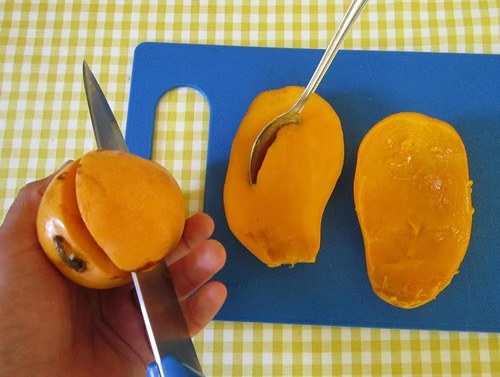 |
| Cutting a mango. |
Greetings from Mexico, and happy fruit hunting!
 |
Ted Campbell is a freelance writer, Spanish-English translator, and university teacher living in Mexico.
He has written two guidebooks (ebooks) about Mexico, one for Cancun and the Mayan Riviera and another for San Cristobal de las Casas and Palenque in Chiapas, both also available at Amazon.com or on his website.
For stories of adventure, culture, music, food, and mountain biking, check out his blog No Hay Bronca.
To read his many articles written for TransitionsAbroad.com, see Ted Campbell's bio page.
|
|
